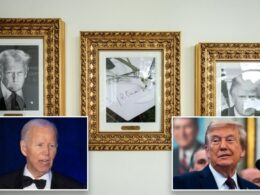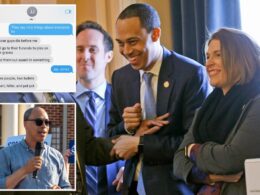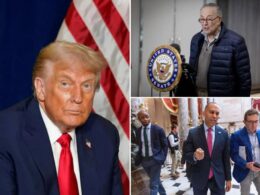WASHINGTON — President Trump’s proposed $2,000 tariff dividend checks for American citizens are coming, he promised — but no date has been finalized yet.
The president gave an update on the timing of the potential payouts on Friday, saying they won’t come in time for the Christmas shopping season.
Instead, he said he’s planning to dole them out in 2026 as he grapples with a tough midterm election cycle.
“It will be next year. The tariffs allow us to give a dividend. We’re going to do a dividend and we’re also going to be reducing debt,” Trump told reporters aboard Air Force One en route to Mar-a-Lago.
Looming over the tariff dividends are concerns that the Supreme Court could strike down Trump’s “trafficking” and “reciprocal” tariffs following a tough oral argument for the administration.
When asked if Trump would still send out tariff dividend checks if the Supreme Court rolls back his tariffs, Trump said, “Then I’d have to do something else.”
Additionally, the tariff rebate would need approval from Congress, where several Republicans have previously expressed skepticism, and instead said Trump should be focusing on slashing the federal budget deficit.
Trump administration officials have given few specifics about how tariff rebate checks would work. Last week, Treasury Secretary Scott Bessent explained that the administration was still figuring out an income limit.
“Well, there are a lot of options here that the president’s talking about a $2,000 rebate and those — that would be for families making less than, say, $100,000,” Bessent told “Fox & Friends” last Wednesday.
Then he quickly clarified that “it’s in discussion” and “we haven’t” decided on that limit.
The president unveiled the proposal earlier this month and caveated that the plan is to exclude “high income people,” without specifying a specific income threshold.
Trump announced the plan shortly after a majority of justices on the Supreme Court sounded deeply skeptical of the tariffs he’s implemented under the International Emergency Economic Powers Act (IEEPA).
Since early on in his second term, Trump has used IEEPA, a statute that doesn’t mention the word tariffs at all and that no president prior to him has used to impose duties, to slap customized tariffs on virtually every country.
The IEEPA tariffs have brought in some $90 billion between their implementation and Sept. 23, according to data from US Customs and Border Patrol.
For context, all of Trump’s tariffs, including the IEEPA ones and other duties that weren’t in the Supreme Court’s crosshairs, took in $195.9 billion between the start of fiscal year 2025 and Aug. 31, per US Customs and Border Patrol data.
Many of those tariffs, especially the IEEPA ones, were not fully implemented at the start of fiscal year 2025, which means the administration could raise more revenue from them if they were kept in place for a full fiscal year.
If the $2,000 dividend payments were narrowed to individuals earning under $100,000, it would cost about $300 billion, according to an estimate from Erica York, the Tax Foundation’s vice president of federal tax policy.
A COVID-19-era proposal to dole out $2,000 checks to families was estimated to cost some $464 billion, according to the Committee for a Responsible Federal Budget.
Should Trump lose the Supreme Court case on the IEEPA tariffs, he could be forced to refund them, though it’s not entirely clear how that process would work.








